Pursuant to the Department of Budget and Management (DBM)-Department of Education (DepEd) Joint Circular No. 1, s. 2021, this Department issues the enclosed Guidelines on the Provision of Special Hardship Allowance (SHA) for Public School Teachers, which not only improves the processes and procedures for availing of the said allowance in consonance with the intention of Republic Act No. 4670 or the Magna Carta for Public School Teachers but also provides a more objective basis for the provision of SHA to qualified teaching personnel, particularly through the adoption of the Hardship Index.
This policy shall be applicable starting FY 2021. All existing DepEd issuances inconsistent with the provisions of these guidelines are rescinded.
For more information and queries, please contact the Bureau of Human Resource and Organizational Development-School Effectiveness Division (BHROD-SED), 4th Floor, Mabini Building, Department of Education Central Office, DepEd Complex, Meralco Avenue, Pasig City, through email at bhrod.sed@deped.gov.ph or telephone number (02) 8633-5397.
Immediate dissemination of and strict compliance with this Order is directed.
Table of Contents
DEPED GUIDELINES ON THE GRANT OF SPECIAL HARDSHIP ALLOWANCE FOR PUBLIC SCHOOL TEACHERS
RATIONALE
The Department of Education (DepEd) recognizes that in order to make education more accessible to all, it is necessary to recruit, retain, and encourage personnel to work in hard-to-reach, far-flung stations as well as those with more challenging working conditions. The grant of incentive pay to such teachers, particularly a Special Hardship Allowance (SHA), is supportive of this cause.
Pursuant to Section 19 of Republic Act No. 4670, otherwise known as the Magna Carta for Public School Teachers, DepEd has been providing SHA as additional compensation to teachers who are “exposed to hardship such as difficulty in commuting to the place of work or other hazards peculiar to the place of employment, as determined by the Secretary. ” Consequently, the Department of Budget and Management (DBM) issued the National Budget Circular (NBC) No. 514, s. 2007 to operationalize the provision of SHA.
While these policies provided guidance in the payment of SHA, implementation challenges surfaced during field monitoring. The concerns primarily centered on the need to come up with a more objective method of identifying recipients and streamlining the long process of availment. These changes are essential to rectify varying interpretations of the NBC 514.
The United Nations Children’s Fund (UNICEF) together with DepEd, conducted a study on the provision of SHA: from the identification of recipients to the actual payment of allowance. The study revealed that the current decentralized processing of the SHA leads to variation in the interpretation of the guidelines resulting in different computations, particularly in the absence of a standardized tool for calculating the individual SHA per teacher.
The study also uncovered other major hardship factors contributing to the difficulty of situation in schools, aside from transport inaccessibility stipulated in NBC 514. The most significant of these factors are: time and cost of transportation from school to Schools Division Office (SDO), human violence, availability of temporary learning spaces, level of poverty, and availability of basic amenities and services, such as telecommunication, water, and electricity.
Thus, these guidelines are issued to ensure a streamlined, more objective, and efficient process of SHA payment to qualified teachers.
SCOPE
This DepEd Order defines the roles and responsibilities of the Central Office (CO), Regional Office (RO), and Schools Division Office (SDO) for the provision of SHA to qualified personnel.
DEFINITION OF TERMS
Alternative Learning System (ALS) refers to a parallel learning system that is a viable alternative to the existing formal education instruction. It encompasses both the non-formal and informal sources of knowledge and skills.
ALS Mobile Teacher refers to a specialized public school teacher conducting learning sessions using the alternative learning delivery mode whose duties require movement from one station to another in depressed, disadvantaged, and underserved communities.
District ALS Coordinator (DALSC) refers to a public school teacher who is officially designated by the Schools Division Superintendent (SDS) to perform coordination functions for the ALS program in addition to his/her regular duties as a learning facilitator.
Hardship Index (HI) refers to any number from 0 to 1 representing the degree of hardship of a particular school combining all the variables identified as hardship factors: time and cost of transportation from school to Schools Division Office (SDO), human violence, availability of temporary learning spaces, level of poverty, and availability of basic amenities (e.g. telecommunication, water and electricity services). The closer the value of the index to 1, the higher the degree of difficulty of the school situation.
Hardship Post (HP) refers to a workstation (Public School/Community Learning Center) located in areas characterized by extraordinarily hard, uncomfortable and extreme difficulties based on the hardship factors measured by the HI.
Multi-Grade (MG) Teacher refers to a public school teacher handling a combined class of two or more grade levels.
Permanent Appointment refers to the appointment issued to a person who meets all the qualification requirements of the position to which he/she is being appointed to, including the appropriate eligibility, in accordance with the provisions of law, rule and standards promulgated in pursuance thereof.
Provisional Appointment refers to the appointment issued to an appointee who meets all the requirements of the position except the eligibility but only in the absence of a qualified eligible available who is willing to accept the appointment, as certified by the Schools Division Superintendent.
Pure Multi-Grade (MG) School refers to a school that solely offers combined classes of two or more grade levels except for Kindergarten.
School Head refers to a person responsible for the administrative and instructional supervision of the school or cluster of schools.
Special Hardship Allowance (SHA) refers to an additional compensation generally paid to teachers who are exposed to hazards and difficulties because of the nature and/or location of their work.
Substitute Appointment refers to the appointment issued to an appointee when the regular incumbent of the position is temporarily unable to perform the duties of the position.
Teacher refers to a person engaged in classroom teaching, in any level of instruction, on full-time basis, including guidance counselors, school librarians, industrial arts or vocational instructors, and all other persons performing supervisory and/or administrative functions in all schools; but shall not include school nurses, school physicians, school dentists, and other school employees.
Temporary Appointment refers to the appointment issued to an appointee who meets all the requirements of the position except the education but only in the absence of applicants who possess the minimum educational qualification, as certified by the Schools Division Superintendent.
POLICY STATEMENT
Anchored on the policy of the State to promote and improve the social and economic status of public school teachers, their living and working conditions, their terms of employment and career prospects, this DepEd Order is thus hereby promulgated to clarify guidelines on the purpose, coverage, eligibility criteria, and the procedures on the grant of SHA, taking into consideration the conditions of the schools identified under hardship categories.
GENERAL GUIDELINES AND OTHER ELIGIBILITY CONDITIONS
1. The following public school teachers are eligible for the provision of Special Hardship Allowance (SHA):
a. All teachers in elementary and secondary schools in hardship post as determined by the hardship index;
b. Multi-grade teachers in pure multi-grade schools;
c. Mobile teachers, and Alternative Learning System (ALS) Coordinators concurrently handling ALS classes; and
d. School heads assigned in hardship post or pure multi-grade schools.
The qualified teachers may either be resident or transient, having permanent or provisional or substitute or temporary appointment.
2. All qualified recipients shall receive the SHA amounting to twenty-five percent (25%) of their monthly salary for a period of ten (10) months for every fiscal year, which shall be released on a quarterly basis.
3. For qualified personnel who meet more than one (1) criterion (e.g. a pure MG school is also categorized as a hardship post) the MG teacher shall receive SHA on only one criterion.
The SHA shall be withdrawn if:
a. The qualified personnel from a hardship post transfers to a non-hardship area;
b. The qualified personnel from a pure MG school transfers to a non-hardship post or a non-pure MG school;
c. The school is no longer a pure MG school (offering both MG and monograde classes); and
d. The mobile teacher or DALSC is no longer handling ALS classes.
PROCEDURES
1. Identification of Schools as Hardship Posts
a. The method for deriving the Hardship Index was through a multivariate regression analysis, wherein the link between school characteristics and the proportion of experienced teachers in a school was analyzed. The variables included are as follows:
- Travel time to SDO;
- Travel cost to SDO;
- Poverty Incidence of Municipality;
- Occurrence of Violent Acts within the school and immediate surroundings;
- Access to electricity;
- Access to water supply;
- Access to internet connection; and
- Existence of Temporary Learning Spaces
b. In calculating the HI of all public schools, the data on the identified eight (8) variables shall be sourced from the enhanced Basic Education Information System (BEIS) and other relevant data and information sources that are available or may be developed, such as the Philippine Statistics Authority’s multi-dimensional poverty index.
c. The Bureau of Human Resource and Organizational Development (BHROD) – School Effectiveness Division (SED) shall compute for the HI of all schools every three (3) years.
d. Under the hardship post category, teachers in schools with an HI level equal to or greater than the set HI cut-off level will be eligible to receive the SHA. Said HI cut-off level shall be effective for three (3) years.
e. Starting FT 2021, teachers assigned in schools with Hl of 0.37 and above shall be eligible to receive SHA. Attached as Annex A is the list of hardship posts with the corresponding HI.
READ: Complete List of DepEd Hardship Post Schools
2. Computation of the SHA
a. Eligible DepEd personnel shall be provided with SHA equivalent to twenty-five percent (25%) of their monthly basic salary, computation of which shall be reckoned from the first day of their assignment to hardship post/MG schools. The formula for the computation of SHA shall be in accordance with Section 5.5 of DBM-DepEd JC.
b. The individual SHA amount shall depend on the qualified personnel’s salary grade level and corresponding step increment as well as the number of actual days the personnel is physically present in the school / learning center. The Daily Time Record (DTR) or any attendance and monitoring form, as prescribed by applicable policies, approved by the Head of Office shall serve as basis for the attendance of the personnel.
c. A cluster school head handling two or more hardship posts/pure MG schools shall be qualified to receive SHA in proportion to the actual number of days he/she is present in those schools. In no case shall the cluster school head be granted SHA more than the rate as computed in Section 5.5 of the DBM-DepEd JC.
3. Budget Allocation and Release
a. The Bureau of Human Resource and Organizational Development (BHROD) – School Effectiveness Division (SED) shall identify the schools considered as hardship posts based on the HI cut-off and compute the corresponding budget allocation for the qualified personnel eligible for the SHA.
b. Regional lump-sum specific for the payment of the Special Hardship Allowance are allocated in the Special Provisions of the GAA every fiscal year.
c. The Bureau of Learning Delivery (BLD) and the ALS Task Force shall submit to BHROD-SED the list of pure MG schools and ALS mobile teachers and DALSCs, respectively, eligible to receive the SHA for computation of the corresponding budget allocation.
d. The Schools Division Office (SDO)-Curriculum Implementation Division (CID) in coordination with the SDO-Planning Officer shall provide the SDO-Personnel Unit the list of qualified personnel in hardship posts, pure MG schools and ALS mobile teachers and DALSCs for computation of SHA.
e. SDO-Personnel Unit in coordination with the SDO-Finance Unit shall submit a funding request to the Regional Office-Finance Division with the list of eligible personnel and the estimated 10-month funding requirement during the 1st Quarter of the Fiscal Year.
f. RO-Finance Division shall transfer the fund from the Regional Lump-sum for Special Hardship Allowance to the SDOs thru the issuance of SubAllotment Release Order (Sub-ARO) based on the request subject to availability of funds.
g. SDO-Personnel Unit shall prepare the SHA payroll quarterly and submit to SDO-Finance Unit.
h. SDO-Finance Unit processes payment of SHA to entitled personnel on a quarterly basis.
i. SDO-Personnel Unit, in coordination with SDO-Finance Unit, submits list of teachers who received SHA to RO-Personnel Unit through email every six (6) months. Attached as Annex B is the reporting template.
j. RO-Personnel Unit consolidates SDO reports of SHA recipients and submits every six (6) months to the Central Office, through the BHROD- School Effectiveness Division (SED) via email address bhrod.sed@deped.gov.ph.
MONITORING, FEEDBACK AND TECHNICAL ASSISTANCE
- BHROD shall continuously gather feedback on the implementation of the Special Hardship Allowance Policy from all concerned stakeholders through online feedback forms to be accomplished by the SHA recipients. It shall conduct a periodic review of this policy to further enhance its provisions and effectiveness. A separate communication shall be issued to this effect.
- The offices accountable for monitoring the timely payment of SHA to qualified DepEd personnel shall be the Personnel Units of both the Schools Division Office and Regional Office.
- The offices accountable for the accuracy of the BEIS data and other relevant data (pure MG and ALS) used for SHA shall be the School Governance and Operations Division (SGOD) and CID, respectively. Issues concerning inclusion and exclusion of schools in SHA shall be addressed by these said offices.
- To ensure the smooth implementation of the SHA, the SDOs shall conduct orientation at least once a year and provide technical assistance to schools, as deemed necessary.
REFERENCES
a. R.A. 4670, Magna Carta for Public School Teachers (1966);
b. Joint Circular No. 1, s. 2021, “Revised Guidelines on The Grant of The Special Hardship Allowance”;
c. DBM National Budget Circular No. 514, s. 2007, “Guidelines on the Grant of Special Hardship Allowance”;
d. Unpublished technical working paper on Special Hardship Allowance prepared by UNICEF (2016); and
e. CSC Resolution No. 1701009, “Omnibus Rules on Appointments and Other Human Resource Actions” (2017).
EFFECTIVITY
- This Order shall be applicable starting FY 2021 and shall be registered with the Office of the National Administrative Register (ONAR) at the University of the Philippines (UP) Law Center, UP Diliman, Quezon City.
- All existing DepEd issuances inconsistent with the provisions of these guidelines are hereby rescinded.
DEPED ORDER NO. 039, s. 2021
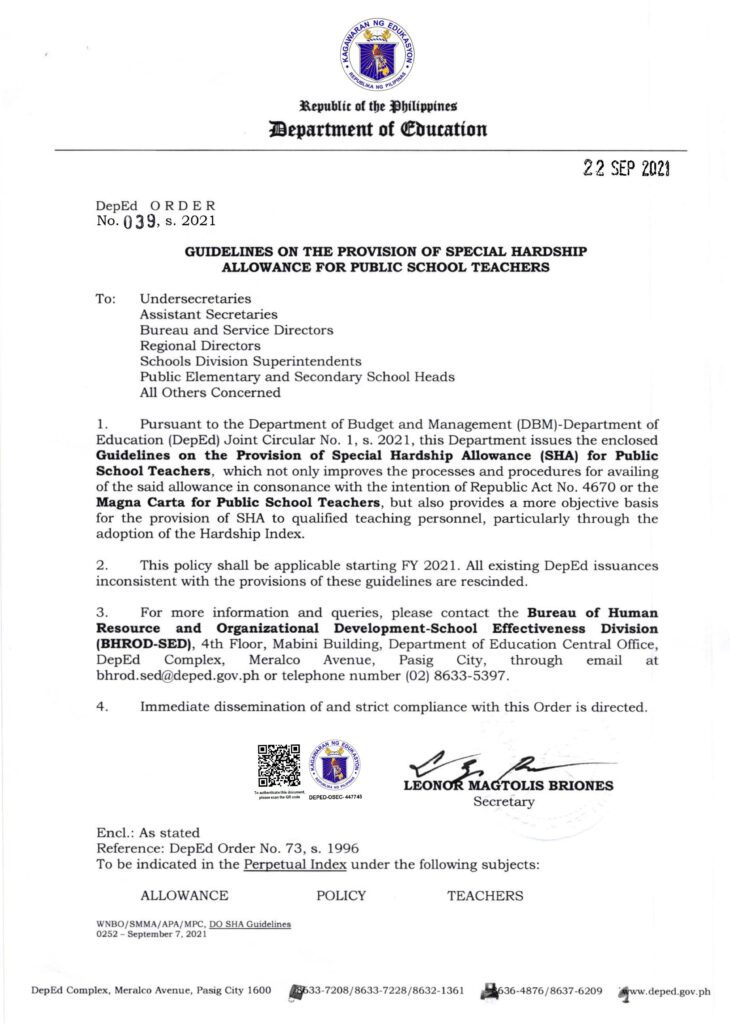
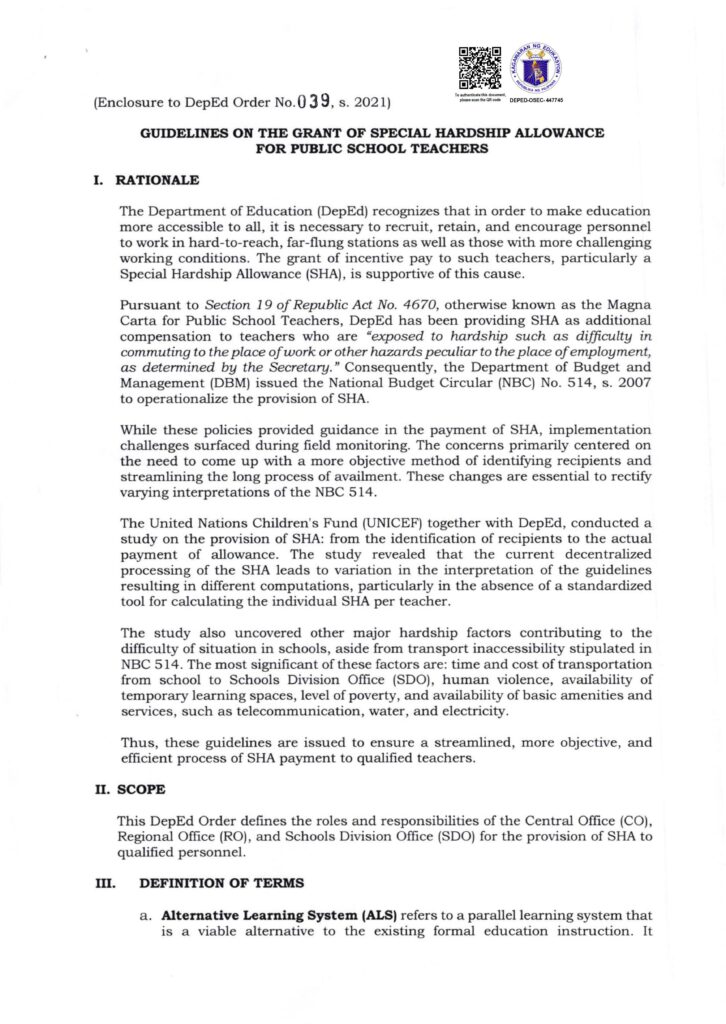
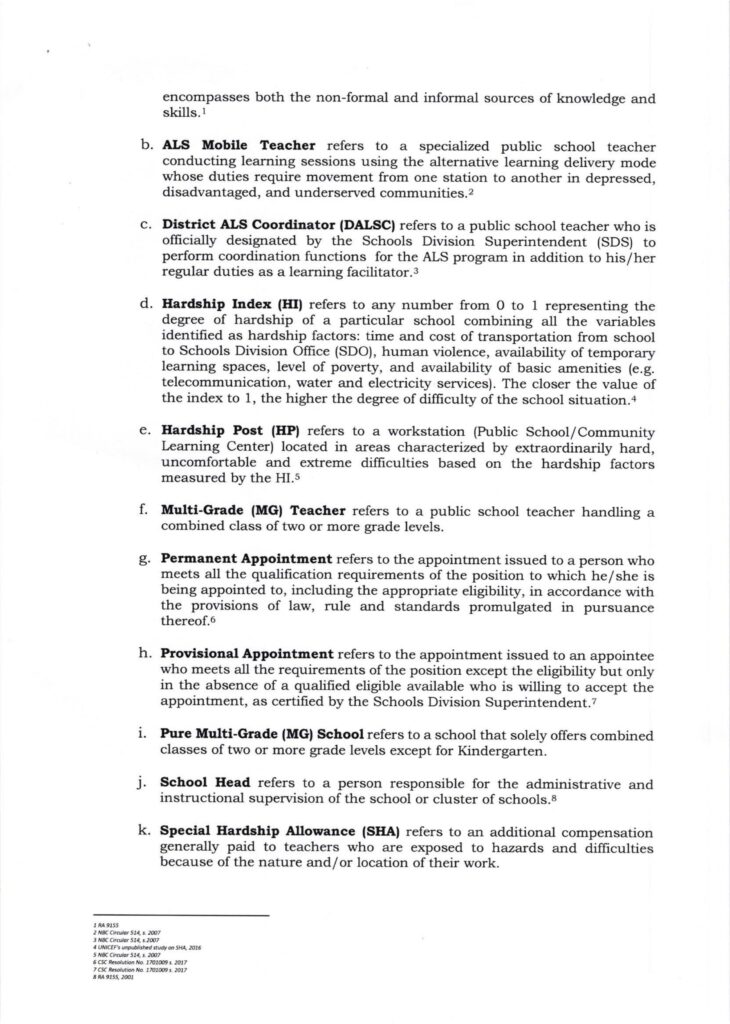
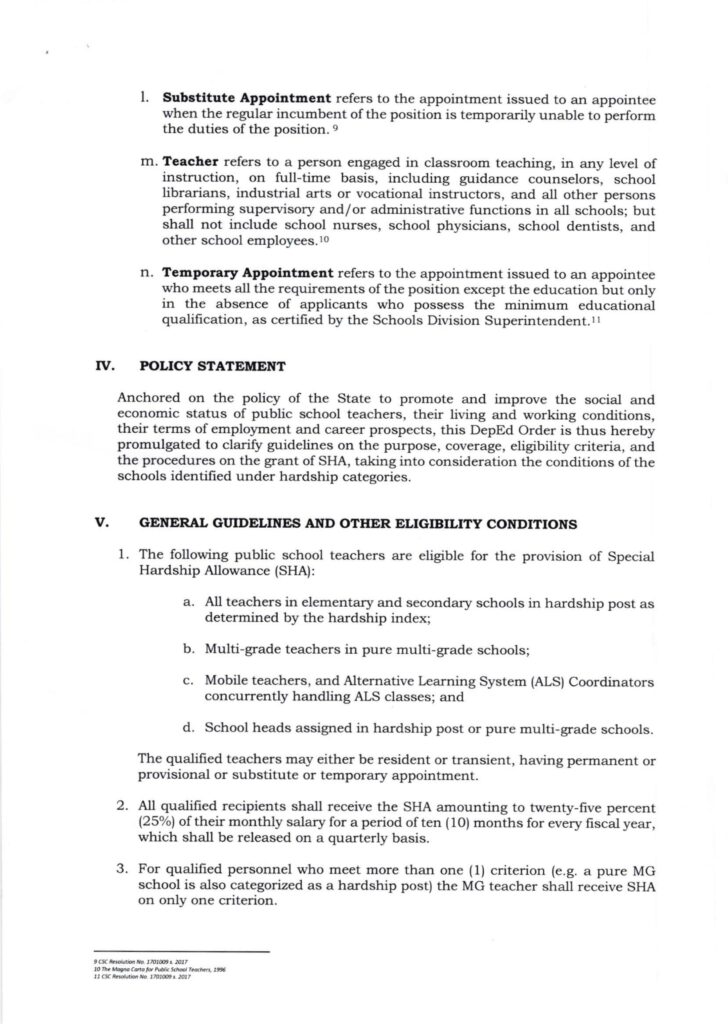
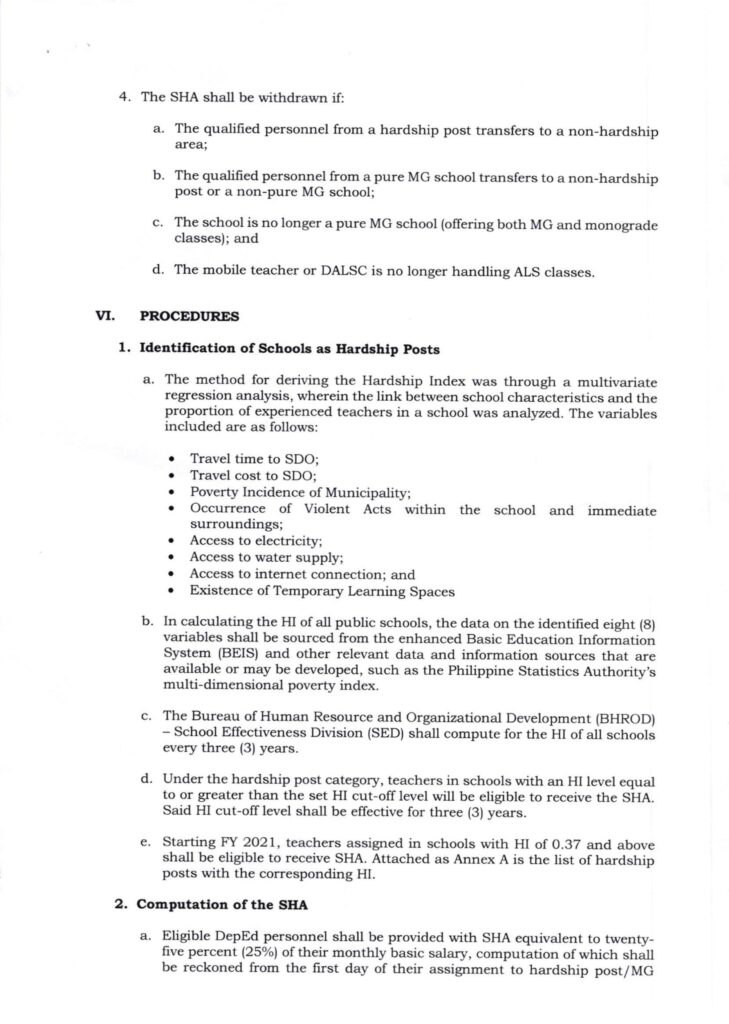
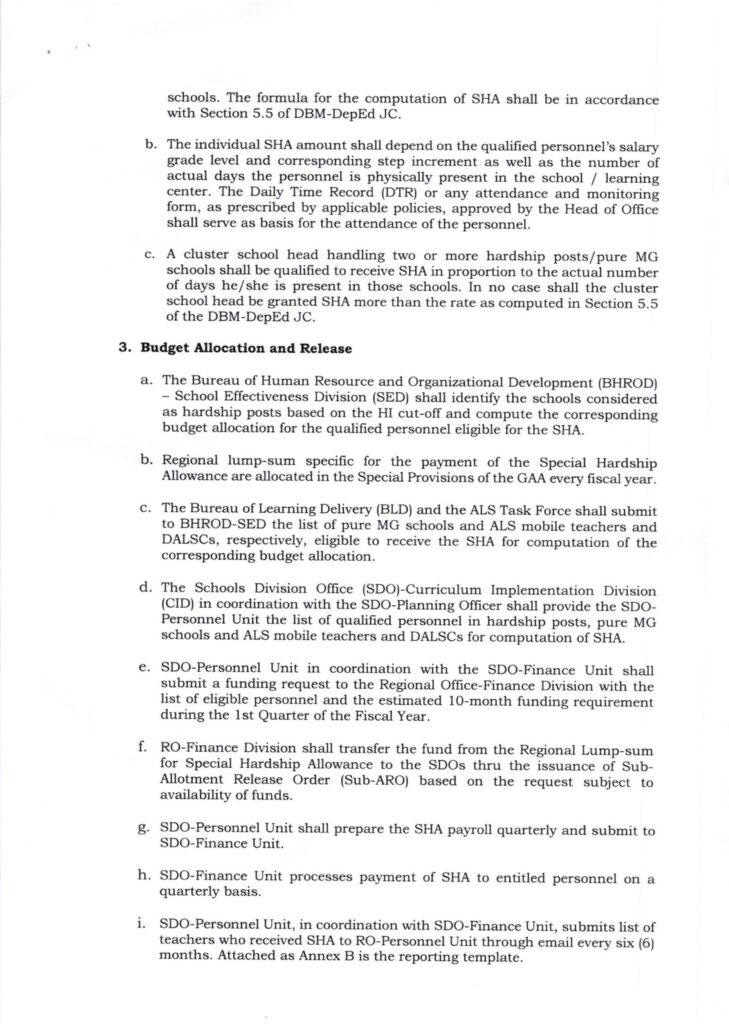
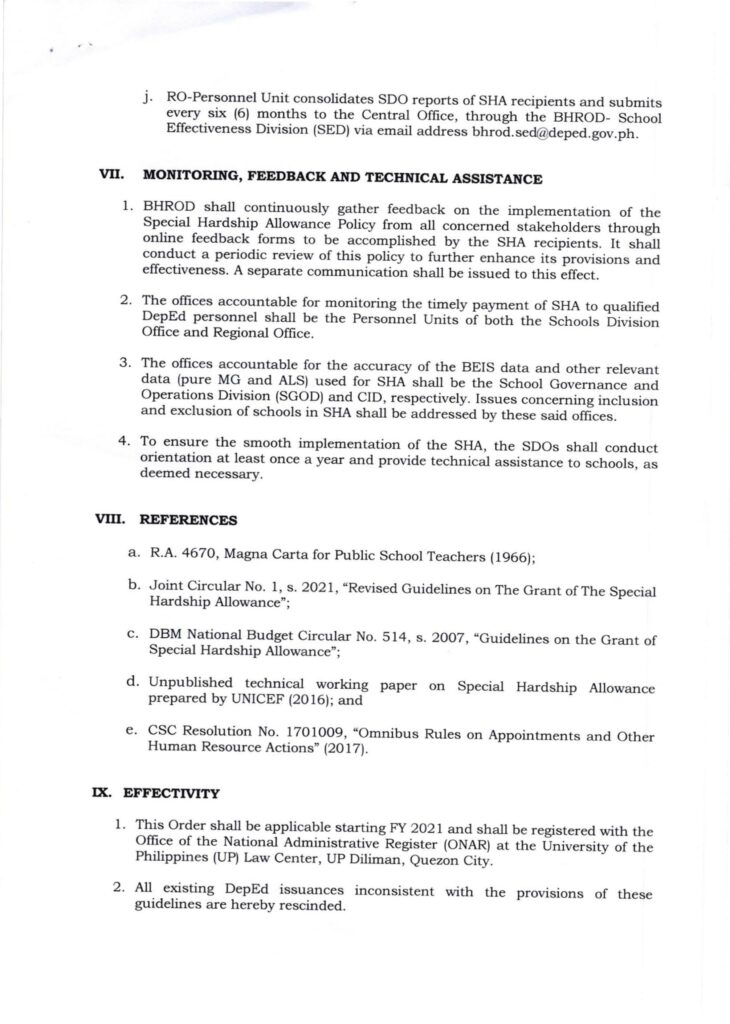
Good evening po. I just want to inquire if may Tax po ba ang MG allowance?